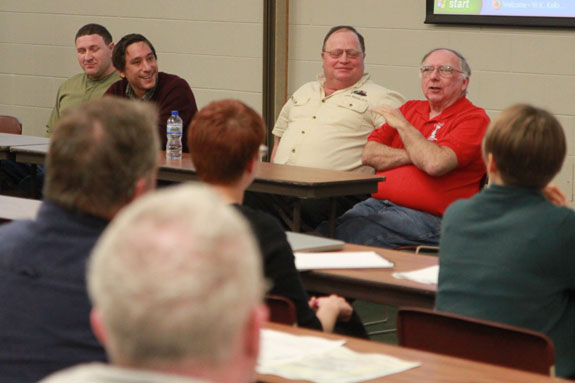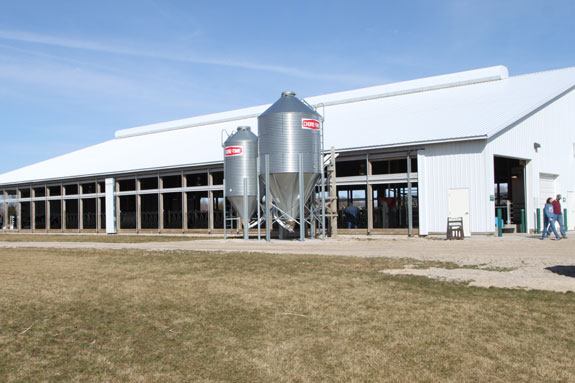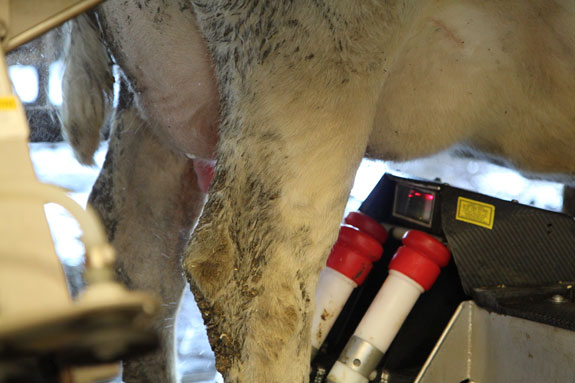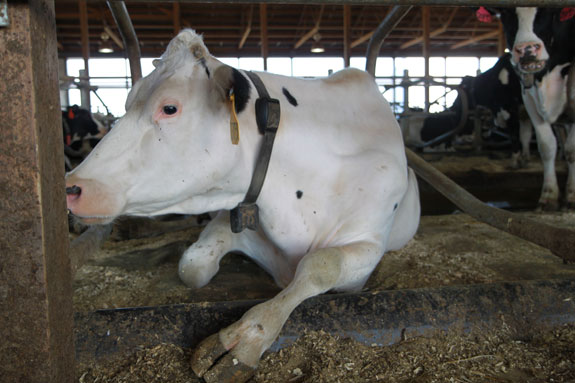This article was #9 of the Top 25 most well-read articles on www.progressivedairy.com in 2012. to jump to the article. It was published in the March 30, 2012. Click here for the full list of the Top 25. Advanced Comfort Technology, Inc’s Holly Harper attended a biannual gathering of Michigan’s Robotic Milking User Group in March. Harper provided an overview of the group’s history (it was founded in 2010) and then a recap of what was discussed at that meeting. We found one of the most interesting topics discussed was that some producers were playing calf sounds in the robot stalls to help the cows let down their milk more quickly.
We asked Harper to follow up with the group and find out:
Q. What’s the best piece of advice you ever received through the Robotic Milking User Group? How were you able to improve your operation because of that advice?
Steve Foley of Millington, Michigan, is a member of the Robotic Milking User Group. He enjoyed being able to hear about and discuss the wide variety of challenges, big and small, of folks during the transition to robots. Being able to be a part of the conversation helped Foley realize that he had relatively few issues compared to some of his peers.
“I did decide that everyone had some challenges, and mine were simple compared to theirs, so that made me feel more confident that we were going to be just fine,” Foley said. He has three robotic units and beds his cows on dual-chamber cow waterbeds.
A major takeaway for Foley from his experience with the group and with his robotic milking units would be that no robot and no dairy is the same.
“Keep playing with the robot; you can’t hurt it,” he said. “Nothing is right or wrong. Find what works for your farm and go with it.”
Following this advice has made it easier for Foley to try different things and not be scared of an unlikely disaster. Having trust in the system is important, and so far for Foley, this strategy is working very well.
—Holly Harper, Advanced Comfort Technology, Inc.

ARTICLE :
It has been true for centuries; farmers talk across the fence, sharing tips and advice with each other to help solve problems and make decisions.
Now, with a commitment by Michigan State University to facilitate conversation in person and online through the school’s Robotic Milking User Group , neighborly dialogue is possible for the handful of Michigan farmers, hundreds of miles apart, who are milking with robots or considering a purchase.
The Robotic Milking User Group is tailored to farmers looking to install automatic milking units or who have already made the leap but now have more questions than the dealer or service tech can tackle.
"The greatest value of the Robotic Milking User Group is that it provides the producers a chance to network and share experiences," said Mat Haan, project coordinator at MSU’s Pasture Dairy Center at the W.K. Kellogg Biological Station in Hickory Corners, Michigan. "There are currently so few farms using robotic milking, they are so spread out, and they are relatively new to the area, that producers do not have a local peer group that they can call on if they have a question about something on their farm."

Social network
The Robotic Milking user group was founded in 2010 at the request of a dairy producer who wanted to get together with other robot users to share information. Today, the group meets twice a year at rotating sites.
"One nice thing we have about our robot users group: We have email capabilities within the group," said Howard Straub of St. John’s, Michigan. Straub has two robotic units and milks 102 cows in a combined freestall/pasture grazing facility. "One time I sent in a question and got eight answers."
Click here to read Progressive Dairyman 's feature on Straub's operation in the article, "Robots on a grazing dairy give Michigan couple 'Freedom.'"
The group includes dairy producers in Michigan and Indiana, extension educators and researchers at MSU, and industry representatives.
"You find out what problems other people have and try to prevent those problems on your farm," said Steve Foley, a new member of the group milking 140 cows in Millington, Michigan. Foley has three robotic units and beds his cows on dual chamber cow waterbeds. "It’s just interesting to find out what other people are doing. You’re learning the little things to make it all work."
The Robotic Milking User Group held its biannual gathering on March 13 at the W.K. Kellogg Biological Station to brainstorm and discuss progress on their farms.
 "Any questions or concerns, we can share with each other,” said Amy Martin, of Gingrich Dairy Farm, in Leroy, Michigan. Martin is installing eight robots this spring in a facility growing to 420 cows and bedding on mattresses. "You can get six or seven different ideas until you figure out what you want to try, what works for you. Everybody is a little bit different."
"Any questions or concerns, we can share with each other,” said Amy Martin, of Gingrich Dairy Farm, in Leroy, Michigan. Martin is installing eight robots this spring in a facility growing to 420 cows and bedding on mattresses. "You can get six or seven different ideas until you figure out what you want to try, what works for you. Everybody is a little bit different."
This time the group went a step farther to help out. Many of the members stayed after the half-day discussion, volunteering their time to answer additional questions from producers in the region who are considering a switch to robots.
Q & A with those who know
Four farmers sat in front of a crowded auditorium taking questions about cost, production, milking frequency, feeding, maintenance, capacity per robot, training first-calf heifers and more. As curious farmers raised questions, the four would answer and other robotic users in the audience of more than 75 attendees could also chime in.
Here’s a small sampling of what we learned:
Q: What’s the most common problem with the robots?
A: The first year is the hardest.
"The learning curve for the robots and the computer program is pretty steep," said Howard Straub. "By the end of that first year, you’re pretty well into it and things go pretty smoothly."
How many cows should be assigned to a unit? That depends on how fast your cows milk and your situation.
"We got to 136 cows [on three robots] and are shipping just as much milk as we were with 168 cows, so you just have to find your own number," said Jeremy Dankert a producer from Bremn, Indiana, who uses a combined freestall/pasture grazing facility.

Q: What has changed for you in maintaining the barn with the robots?
A: Overall, more time to tend to the cows.
"When we do our cleaning, we get more turns on the robots," said Dankert. "We stir them up a bit because we’ll get cows that are getting a little lazy."
Although Dankert didn’t see a problem with rousing the cows to bed the barn, Santiago Utsumi, associate professor of animal science at MSU’s Kellogg farm had a different perspective.
Kellogg farm milk is milking 100 cows using two robotic units and bedding on a combined dual chamber cow waterbed free stall system and pasture grazing.
“In this situation we are stepping back and giving the cows their own chance to make decisions,” he said, “and we are making an environment that is facilitating the cows to make their own decisions – a good environment, good layout that is not affecting their flow of movement.”
The pasture grazing allows the cows to flow naturally in and out of the milking stalls when they are outside, and the waterbeds require a minimal amount of maintenance and cleaning, with no need to rouse a sleeping cow at the times when they are housed inside. Overall, the system allows the cows to truly make their own decisions.
Q: What do you feed through the robots?
A: Something irresistible.
“What you feed in the robot, you need to make sure it is different than what you feed in the barn,” said Utusmi. “If you’re feeding a really hot TMR in the feed barn, then you’re challenging the robot…You should be feeding about 20 percent of the requirements of the cow through the robot.”
The panelists fed a variety of items including pellets, meal and a roasted bean/corn mix.
Q: What have you saved money or made money on?
A: Vet bills and facilities.
"As much as they talk about the economics, it’s what you don’t need that is surprising," said Sammy Jones of Star City, Indiana, who is milking 109 cows with two robotic units and bedding on sand. "We feed the cows in just 93 feet, using less feeding area and we have no holding area. That’s 40 by 120 feet of concrete that we didn’t have to pour."
The producers overwhelmingly noticed a reduction in mastitis incidences because the robotic units tend to catch cases faster. Production increased for some users who went from two times a day milking, but not for others.
Q: What is one unique thing you’ve tried?
A: Calf sounds.
"We are playing hungry baby cow sounds in the robot stall," said Jones. "It releases oxytocin in their brain and we had some research done by a high school student that it increased milk production by a pound at first and causes them to release their milk faster."
Robot reps take questions
After the farmers spoke, automatic milking unit dealers were on-hand to answer further questions.
Although the most popular question – How much do these units cost? – remained unanswered, the reps were able to give insight on software training, upgrades maintenance, installation and emerging technology.
Here’s a small sampling of what we learned:
Q: Is there a “typical” robot barn?
A: Nope.
"Here in Michigan, we have three farms," said Chad Scholma of Hi-Tech Dairy Supply, a Lely dealer. "They are using sawdust, sand and mattresses. They scrape with skidsteers or alley scrapers. In the Midwest half are in existing facilities; half are new facilities. I haven’t heard any real issues with making automatic milking units work in any situation."
From the users on the panel, there was a wide variety of facilities – new freestall, existing freestalls and hybrid freestall/pasture grazing facilities – and almost all bedding types were represented, from sand and mattresses to waterbeds and deep-bedded sawdust, further indicating that there is no "typical" robot facility.
What can we expect for maintenance costs? Between $200 and $850 per month per unit, depending on the bedding type and routine maintenance done by the producer.
"I tell people, without shooting myself in the foot, that it’s $400 to $450 you have to budget to do maintenance each month. And I tell dairyman [using sand] that you have to double that each month," said Nick Nunkel, Midwest Region Robotic Specialist at DeLaval. "That is all about how much you make sure sand doesn’t get into places you don’t want to get in. You have to think about singeing, not only the udders, but because the arm goes almost all of the way up to the navel, you need to consider singeing all of the way up to the navel to get all of that sand off the cow."
Scholma added that maintenance is "directly related to how well the producer is taking care of their robots. Sand barns have a little bit higher maintenance than a conventional barn, because the bushings are wearing out prematurely."
Conversation works
Attendees were pleased with the information shared from the panels.
"Our parlor is getting old, so we’re trying to decide what to do next," said Delbert Spitzley a producer from Portland, Michigan, who attended the conference. "I’ve only seen one robot in use, so hearing the interviews of all these users was really helpful."
Spitzley milks 300 cows.
“We came to find out something we didn’t know about robots,” said Keith Leipprandt of Pigeon, Michigan. "It was new that you can catch the mastitis soon enough through the robot before the milk gets cloudy or gels, and before a positive on the California mastitis test."
Michigan State is committed to continuing the Robotic User Group and has a Pasture Grazing Workshop scheduled for later in the year.
"This type of program is important because it provides farmers an opportunity to learn from each other," said Haan. "Michigan State and other universities conduct a lot of research and generate a lot of information that can benefit farmers, but sometimes farmers need to hear from other farmers about their experiences and the challenges they face on their farms. Creating opportunities for these peer-to-peer exchanges is as important, and sometimes more important, than providing the most current scientific information."
If you would like more information on the MSU program, click here to email Haan. PD
Holly Harper is the director of communications and west coast sales at Advanced Comfort Technology, Inc., home of DCC Waterbeds , based in Reedsburg, Wisconsin. Click here to email Harper or find her on Twitter at @ hollybluebike .
PHOTOS
PHOTO 1: Dairy producers and members of Michigan State University’s Robotic Milking User Group, from left, Jeremy Dankert, Santiago Utsumi, Sammy Jones and Howard Straub, answer questions about robotic milking for other producers as part of a robotic milking conference panel discussion on March 13, 2012, at MSU’s W.K. Kellogg Biological Station.
PHOTO 2: Producers enjoy a tour of the Kellogg Biological Station dairy farm at Michigan State University on March 13, 2012, as part of a conference on robotic milking. The KBS farm milks 100 cows using two automated milking units and beds their cows in a freestall barn with dual chamber cow waterbeds. The herd is also part of a pasture-grazing research program during the grazing season.
PHOTO 3: A Lely automatic milking unit takes milk from a cow during a tour of the Kellogg Biological Station dairy farm at Michigan State University on March 13, 2012, as part of a conference on robotic milking. The KBS farm milks 100 cows using two automated milking units and beds their cows in a freestall barn with Dual Chamber Cow Waterbeds. The herd is also part of a pasture-grazing research program.
PHOTO 4: A cow rests comfortably on a waterbed after a visit to a Lely automatic milking unit during a tour of the Kellogg Biological Station’s dairy farm at Michigan State University on March 13, 2012, as part of a conference on robotic milking. The KBS farm milks 100 cows using two automated milking units and beds their cows in a freestall barn with dual chamber cow waterbeds. The herd is also part of a pasture-grazing research program. Photos by Holly Harper.






